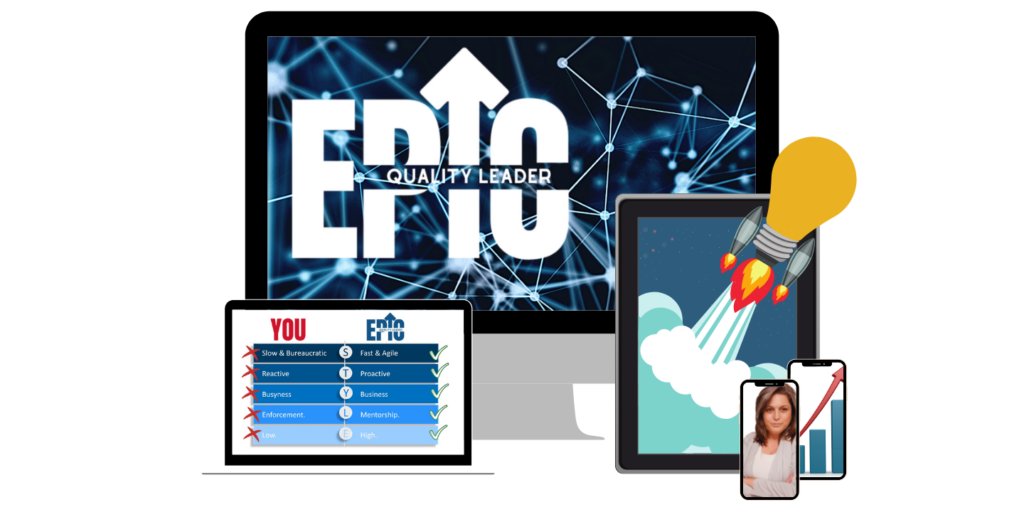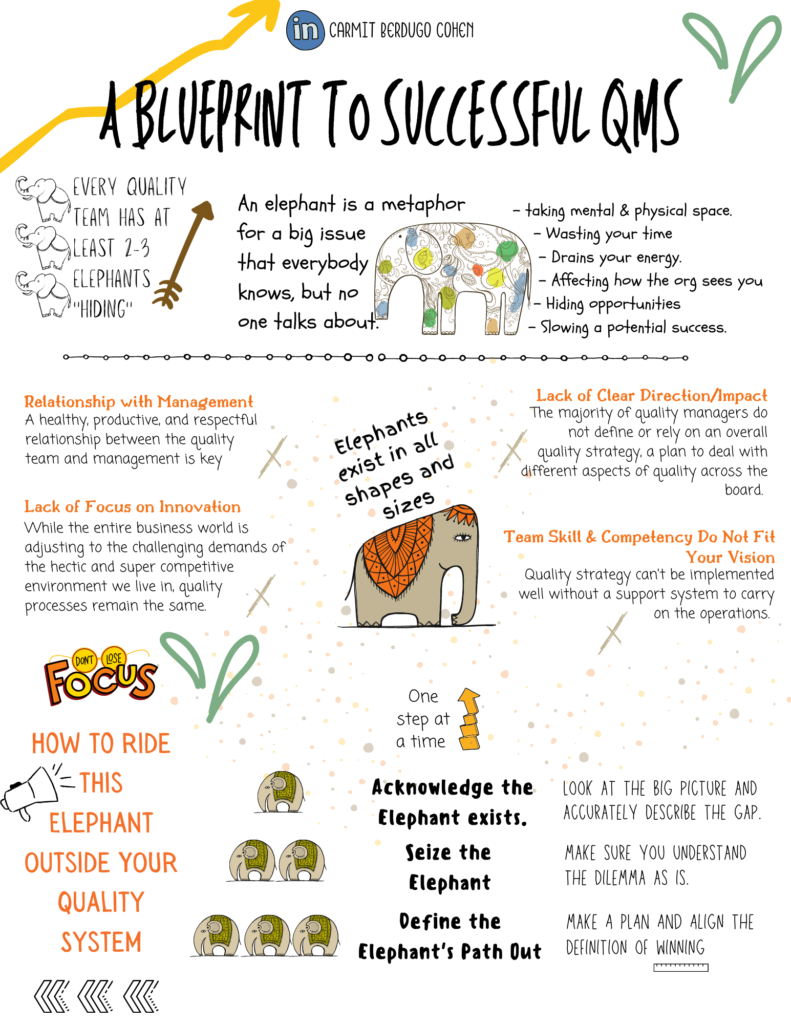
A Blueprint to Successful QMS: Ride this Elephant Outside YOUR Quality System
There are problems that everybody knows very well, but no one talks about because it’s a big issue. Perhaps a sore spot or political sensitivity. It’s something that you and no one else wants to touch with a 10-foot pole (i.e., “elephants”). I’ve had the opportunity to work with quality leaders from different industries worldwide, and I learned that every Quality team has at least 2-3 elephants “hiding” out there.
These elephants are big, taking up a lot of your mental and physical space. When left unresolved, they are wasting your time and drains your energy. And it gets worse; these elephants are affecting how the organization sees you, your team, and the quality system as a whole. They are also hiding opportunities from your view, and in many ways slowing (if not blocking) a potential success.
Elephants often are born and grow from common challenges you didn’t face successfully (yet), due to various reasons, such as the fear of being misunderstood, fear to create antagonism, avoid unnecessary conflicts or, taking it from the positive side, for the sake of maintaining proper working relationships (whatever the reason might be, here is what to do when you don’t know what to do.)
Chances are it caused you some discomfort initially, but over time you become used to living with it. Everybody faces different kinds of elephants, in all shapes and sizes. Few examples are:
Relationship with Management
A healthy, productive, and respectful relationship between the quality team and management is key to success. Ultimately, management commitment can benefit the quality team in a few ways. It can boost the organization’s engagement across quality, increase the team’s budget, assign more resources, and make it easier to handle. But, what happens if the relationship is not blossom as expected? Then, the environment will be less tolerant; it will be harder to get recognition. You might even feel your contribution consistently undermined. It will be challenging for you, if feasible at all, to get extra resources and budget. You will feel disappointed, not appreciated, not inspired, and your team will feel the same.
Lack of Clear Direction or Impact
I don’t savor write the sentence you are about to read, but as the old saying goes: understanding the problem is 50% of the solution. The vast majority of quality managers do not define or rely on an overall quality strategy, a plan to deal with different aspects of quality across the board. And what happens when you don’t have a strategic plan on hand? You fill your time with pieces of action you believe you expected to do, fire fighting, and everything in between. But, do these pieces of works form a coherent whole? Do they bring you closure to the result? But wait…what is this result? Ultimately, how do you define success? What is the vision you are expecting people to align with? Without a clear direction, a north star for everyone that participates in quality activities, you will win some, gain sporadic success, and probably a limited impact. But shouldn’t you aim to optimize your influence and increase team effectiveness? When you are implementing and executing a chosen strategy, you say ‘NO’ to 80% of activities and only focus on the ones that get you closure to the desired outcome.
Team Skill and Competency do not Fit Your Vision
After you’ve put together a strong strategy, you’ve to develop yourself and the team’s capacity portfolio that will suit the plan. Quality strategy, or any strategy for this matter, can’t be implemented well without a support system to carry on the operations. You should take a good look in the mirror and ask yourself, do your people demonstrate sufficient expertise? Do they have the required competencies? Can you count on their knowledge, skills, judgment, and attributes to perform the job effectively? Can they help you to bridge the gap from where you are to where you want to be? You should make sure your team is fitted to support this path. It might be that current knowledge is narrow or that the team sees the quality through a small prism. Soft skills and mindset are also crucial if you want to create a better engagement around quality.

Lack of Focus on Innovation
If you’ll ask me (even if you won’t – I will say it anyway), this is the most prominent and dangerous elephant out of all. While the entire business world is stepping ahead and adjusting to the challenging demands of the hectic and super competitive environment we live in, quality processes remain the same. How unfortunate is that!?.
Look around you- innovation is everywhere. R&D and manufacturing processes are being stretched to their limits in a trial to meet time to market demands and win their market shares. New & emerging technologies are being implemented to enable acceleration in performance, flexibility, customization, and faster response. What about quality? Why are quality processes not being reinvented to meet these new challenges? Are you genuinely expecting the entire organization to follow slow-moving & sometimes bureaucratic methods just for the sake of quality?
While there is no ‘one size fits all’ approach for dealing with your elephants, here are some strategies to stop the foot-dragging and ride these elephants outside your quality system effectively:
Acknowledge the Elephant Exists.
It’s not only about facing yourself in the mirror and acknowledges there is a problem, but also about gathering the mental strength and willingness to confront the issue and deal with it. After you dared to admit it to yourself, you should understand the true nature of the problem. At this point, you should align with a few people you trust to make sure the elephant is real. Once confirmed, define a clear problem statement, not more than one sentence long. Look at the big picture and accurately describe the gap.
Seize the Elephant
As with the six blind Indian men; good chances that you see only one aspect of the problem or look at it from your specific prism. Hence, make sure you understand the dilemma as is. Define the problem statement as clear as it can get. It will help you define the strategy later on. Gather as much data to help you drill down to the heart of the matter. If you don’t have meaningful data to estimate the issue’s size accurately, define what data is needed, and collect it. Be creative in gathering the data; create and publish surveys with close and open-ended questions to allow a qualitative and quantitative look at the issue. Encourage people to speak. Initiate ’round tables’ meetings with different groups, and ask every participant to express their thoughts on a specific matter. Allow them to share their perspectives on what is working well and what needs improvement.

Define the Elephant’s Path Out.
Now it’s time to come up with a strategy and make a plan to get this elephant out of your system in 3 simple steps:
(1) Align the definition of winning. Ask yourself what outcome you’d like to see? What would you like to accomplish at the end of the process?
(2) Once you understand what success means for you, look again at your problem statement. You might think it is overwhelming, too big for you to solve. The key here is to break the problem down into smaller pieces that make sense to you. When you break a problem down into its parts, not only it becomes more easily manageable, but the solution becomes much more straightforward. Focus on processes and interfaces rather than on individuals. Keep in mind that people may switch positions over time, but your goal is to have a robust solution that doesn’t depend on a specific person.
(3) Create a timeline for completing the plan and share it with your peers and managers. When you are committed to a strategy and deadline, you say ‘NO’ to many time-wasting activities with minimal value. In other words, you become focused, and as side effects increase your effectiveness.
Remember,
There is always an option that you are facing several elephants in different sizes and colors. In this case, you will have to decide the right priority and which elephant to tackle first. By no means, don’t try to eliminate all of them at once; it is a proven recipe for failure.
Please stick to the facts and take it one step at a time. It is critical that you will not get emotional. Please don’t blame yourself or others; it will not do you any good. Instead, try to see it as an excellent opportunity for improvement that will benefit you in the long run. Think of yourself one year from now, when people address you, asking to learn how to face their elephants.



No Comments